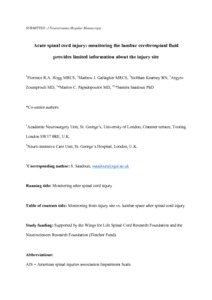Hogg, F; Gallagher, MJ; Kearney, S; Zoumprouli, A; Papadopoulos, MC; Saadoun, S
(2020)
Acute spinal cord injury: monitoring the lumbar cerebrospinal fluid provides limited information about the injury site.
Journal of Neurotrauma, 37 (9).
ISSN 0897-7151
https://doi.org/10.1089/neu.2019.6789
SGUL Authors: Papadopoulos, Marios
![[img]](https://openaccess.sgul.ac.uk/111646/1.hassmallThumbnailVersion/ALTOGETHER.pdf)  Preview |
|
PDF
Accepted Version
Available under License ["licenses_description_publisher" not defined].
Download (3MB)
| Preview
|
Abstract
In some centers, monitoring the lumbar cerebrospinal fluid (CSF) is used to guide management of patients with acute traumatic spinal cord injuries (TSCI) and draining lumbar CSF to improve spinal cord perfusion. Here, we investigate whether the lumbar CSF provides accurate information about the injury site and the effect of draining lumbar CSF on injury site perfusion. In 13 TSCI patients, we simultaneously monitored lumbar CSF pressure (CSFP) and intraspinal pressure (ISP) from the injury site. Using CSFP or ISP, we computed spinal cord perfusion pressure (SCPP), vascular pressure reactivity index (sPRx) and optimum SCPP (SCPP<sub>opt</sub>). We also assessed the effect on ISP of draining 10mL CSF. Metabolites at the injury site were compared with metabolites in the lumbar CSF. We found that ISP was pulsatile, but CSFP had low pulse pressure and was non-pulsatile 21% of the time. There was weak or no correlation between CSFP versus ISP (R=-0.11), SCPP<sub>(csf)</sub> versus SCPP<sub>(ISP)</sub> (R=0.39) and sPRx<sub>(csf)</sub> versus sPRx<sub>(ISP)</sub> (R=0.45). CSF drainage caused no significant change in ISP in 7/12 patients, a significant drop by <5mmHg in 4/12 patients and by ~8mmHg in 1/12 patient. Metabolite concentrations in the CSF versus injury site did not correlate for lactate (R=0.00), pyruvate (R=-0.12) or lactate-to-pyruvate ratio (R=-0.05) with weak correlations noted for glucose (R=0.31), glutamate (R=0.61) and glycerol (R=0.56). We conclude that, after a severe TSCI, monitoring from the lumbar CSF provides only limited information about the injury site and that lumbar CSF drainage does not effectively reduce ISP in most patients.
Statistics
Item downloaded times since 10 Feb 2020.
Actions (login required)
 |
Edit Item |


